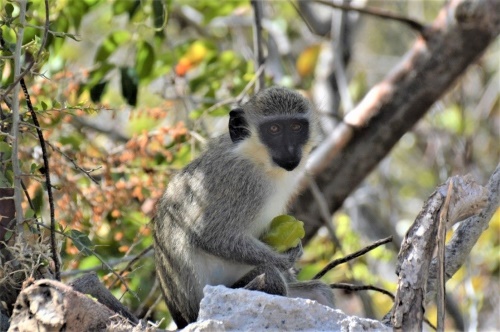 PHILIPSBURG:--- The Nature Foundation started a new project in order to find solutions for the continuing issues created by the invasive monkey species on the island, especially agriculture performers experience negative setbacks due to this invasive species. The Foundation’s first step, under the lead of Alice Manley, will include researching the current monkey population and develop a management plan in order to manage this species, the second step includes finding funding to implement the management plan. Alice Manley, a returning local who recently graduated from Anglia Ruskin University with a B.Sc. in Animal Behaviour, will be interning for the Nature Foundation Sint Maarten and will study this invasive Vervet monkey and possible management options. It is important to study and manage invasive species and make funds available (which are currently not available), as the invasive monkey species could be detrimental to the island’s economy and agriculture.
PHILIPSBURG:--- The Nature Foundation started a new project in order to find solutions for the continuing issues created by the invasive monkey species on the island, especially agriculture performers experience negative setbacks due to this invasive species. The Foundation’s first step, under the lead of Alice Manley, will include researching the current monkey population and develop a management plan in order to manage this species, the second step includes finding funding to implement the management plan. Alice Manley, a returning local who recently graduated from Anglia Ruskin University with a B.Sc. in Animal Behaviour, will be interning for the Nature Foundation Sint Maarten and will study this invasive Vervet monkey and possible management options. It is important to study and manage invasive species and make funds available (which are currently not available), as the invasive monkey species could be detrimental to the island’s economy and agriculture.
Recently, a survey was already placed on the Nature Foundation’s Facebook page that is still active, asking for information from local residents about the monkeys that may or may not be on or near their property. The Nature Foundation will soon be conducting field surveys to find out more information about the species’ movement and abundance on St. Maarten.
Vervet monkeys (Chlorocebus pygerythrus) are a least concern species on the IUCN red list, this species is therefore not endangered or in any trouble of soon becoming endangered. This species is very adaptable and often found in urban areas of Africa, the Caribbean and some countries in South America. As many know, vervet monkeys have become a nuisance on the island of Sint Maarten. This monkey species is an invasive species that is quickly overpopulating. While it is unknown the definite time of introduction, it is believed to have been in the 17th Century when settlers arrived on the island, and again in 1995 after Hurricane Louis damaged the Sint Maarten Zoo. It was stated by a St. Maarten Zoo board member that some vervet monkeys escaped the zoo or were looted and released after Hurricane Irma, increasing the issue of invasive monkey species on St Maarten.
The citizen survey that was placed on the Nature Foundation’s Facebook page has so far reached 53 responses, with 40 individuals saying they have seen monkeys near their residences. “So far, the results from the survey show that most monkeys are recorded by residents on the east side of the island, mainly including Pointe Blanche, Guana Bay and Dawn Beach. With some sights in Pelican Cay, Indigo Bay, South Reward, St. Peters, and Almond Grove. Our results have shown that 75% of our respondents participate in at home agriculture, feeding an average of 4 people per household. Within these respondents another 65% responded that their crops were being affected by the monkeys entering their properties. Many respondents graciously gave us their emails for possible further contact if we need more information. We would like to thank all residents who have participated in our survey” explained Alice Manley.
The Nature Foundation provides a few tips for residents when issues with monkeys are being experienced; drape a thin cloth material or mosquito netting over your crops, pick the fruit as soon as possible, or spray water from a water pistol or hose to chase the monkeys away. Monkeys are naturally afraid of snakes, leaving realistic rubber snakes around your garden is believed to scare them away. Make sure you are often moving the snakes to different areas and not leaving them in one place for too long, as the monkeys are smart and will realize they are not real and ignore them. Further solutions include growing crops the monkeys do not like on your property perimeter, including chilies and ginger, or to buy and set up an animal safe electric fence around your perimeter, to produce small non-fatal shocks to the animals that may touch the fence. Remember to be safe when using the electric fence and to keep children away from it.
The Nature Foundation takes this issue very seriously and has been researching alternative solutions. If you have any monkeys that are commonly in your property please send the Nature Foundation an email at This email address is being protected from spambots. You need JavaScript enabled to view it., please provide as many details as possible, including how many monkeys you normally see, where your property is, and how often you see the monkeys.












